Avatar the Last Airbender the Art of the Animated Series
![]()
Avatar: The Terminal Airbender—The Art of the Blithe Series is an artbook based on the animated series Avatar: The Last Airbender. The book contains concept art, design works, behind-the-scenes commentary by series founders Michael Dante DiMartino and Bryan Konietzko, along with other pieces of production artwork.[2] The book was released in comic volume stores on May xix, 2010 and in general bookstores on June 2, 2010. It consists of 184 pages, separate into five capacity of the aforementioned textile, most of which had never been revealed to the public earlier.[one] [ii] [4]
A second edition of the artbook was released on November 25, 2020, in a standard and deluxe edition, featuring a new cover by Bryan Konietzko, eight pages of new material and an updated foreword by Gene Luen Yang. The deluxe edition besides includes a designed slipcase, an art lithograph, a gilded front cover, and a ribbon marking.[3] [5]
Contents
- 1 Contents
- 1.1 Affiliate One: Early development
- ane.ii Chapter Two: Season I: Water
- one.3 Chapter Iii: Season Two: Earth
- 1.four Chapter Four: Flavour Three: Fire
- 1.5 Chapter Five: Ancillary art
- 2 References
- 3 Run across as well
Contents
The volume contains v capacity:
- Early on development (pages viii through 37)
- Season One: Water (pages 38 through 83)
- Flavour Two: Earth (pages 84 through 129)
- Flavor Iii: Burn (pages 130 through 172)
- Ancillary fine art (pages 172 through 183)
The first edition includes a foreword by the director of The Last Airbender, M. Night Shyamalan (folio half dozen), while in the 2nd edition the foreword was written past Gene Luen Yang, who authored the first five Avatar graphic novel trilogies. The volume also includes an introduction by Avatar creators Bryan Konietzko and Michael Dante DiMartino (page vii). The very terminal page contains a determination, which is over again written by the creators.
The volume explains how the serial was created and gives i an idea of the efforts that went into such an endeavor. Thank you to the many beautiful illustrations, the book also lets the reader get a step further into the deep Globe of Avatar.
Affiliate 1: Early development
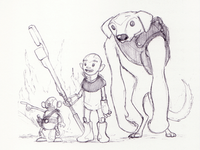
Early concept fine art of Aang, Appa, and Momo.
The pre- and early developmental stages were different to the series created. The 2 creators, Bryan Konietzko and Michael Dante DiMartino, brainstormed ideas on how to brand an animation series, and not only made incredible progress with their dream to make a television show, but also began a journey that would lead them to a lifelong friendship. In the beginning, the show had a futuristic setting; Aang was not an Air Nomad from a hundred years ago, but rather a boy from a lost civilisation from over a thousand years prior. He had a robotic sidekick named Momo-iii, who afterwards became Aang's lemur Momo, and a bear-dog that, while not making it into the series' cut, later became the inspiration for Avatar Korra's brute companion. Co-ordinate to Konietzko, Aang was originally "a farmer kid, shepherding mammoth floating livestock similar huge manatees ..." He also goes on to state the original idea behind the pointer was to go the herd to trust him through imitation. This idea was later dropped, much to Bryan Konietzko's dislike, as there was no place for all of them in every episode. Nevertheless, they likewise played their part in the series, having inspired the idea of Appa.
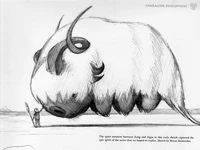
An early on sketch of Appa and Aang to emphasise the "ballsy spirit of the series".
As soon as the serial had progressed to the point where Aang was going to exist a kid frozen in an iceberg for a hundred years, and the last hope for earth peace, the characters of Katara and Sokka were adult. Even though their designs at the fourth dimension were still different, Bryan and Mike both knew that Katara and Sokka were going to become a major role of the show.
According to the two co-creators, in the very beginning the Fire Lord was the only villain planned for the show. Soon nevertheless, Eric Coleman, i of the members of the Avatar squad, suggested an thought which gave birth to Zuko, the banished prince. With their idea finally gear up, Bryan and Mike decided that it was time to make the pilot.
Chapter Ii: Flavor One: Water
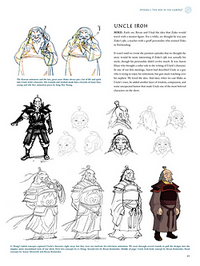
The folio defended to Iroh.
After the airplane pilot and the series were accustomed by Nickelodeon, Bryan and Mike started recruiting a larger squad to make the series. After succeeding in finding a studio in Republic of korea, the team began work on the 2-episode flavor premiere. Iroh was added while making the offset episode; he was at starting time going to be Zuko'due south sifu, only afterward on became his uncle to make the story more personal. According to Bryan, Mako made Iroh's character complete past adding a sense of humour to the graphic symbol.
At showtime, only thirteen episodes were scheduled by Nickelodeon, thus making "The Bluish Spirit" the last episode. However, Nickelodeon's reaction to the thirteen episodes fabricated was highly positive, and they permit the show continue and expand. By the cease of the first season, the series had connected with a broad audience, both male and female person; the creators themselves admitted that they had never expected such a positive reaction and such a large audience.
Chapter Three: Flavour Two: Earth
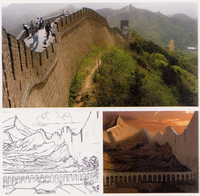
A visual comparison between the Great Wall of Communist china, and the Outer Wall of Ba Sing Se.
In forming the second season, the creators traveled to Red china to gain inspiration - especially the compages. Sites such every bit the Great Wall and the Forbidden City provided the scale used to inspire Ba Sing Se. After stumbling upon an architecture park, the duo plant in an "inspirational goldmine", which happened to characteristic a vast assortment of Chinese architectural styles from a variety of ethnicities and eras.
This chapter shows several of these pictures, alongside the artwork from the series that was inspired by each i. The influences of these images can be seen throughout the Earth Kingdom; the Dandy Wall can be directly related to the Outer Wall of Ba Sing Se.
The third chapter goes into some item of the episodes of the 2nd series; however, information technology also explains and elaborates on the designs and personalities of newly introduced characters, such as Azula, Mai and Ty Lee, and Toph.
Chapter Four: Flavor Three: Burn
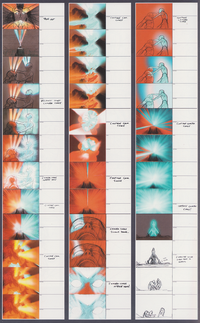
Storyboards of the energybending sequence performed by Aang on Ozai.
The fourth chapter goes into some detail how the third and final serial adult, from the introduction of new characters, such as Combustion Homo and Hama, and the inspiration backside the unique landscape of the Fire Nation.
This chapter showcases a significant number of background sketches and drawings, from Piandao's castle, the Western Air Temple, Wulong Forest and Sozin's Comet, and the sunset over Iroh's tea store.
Burn Lord Ozai is also showcased, given several pages to show the different character designs during different parts of the flavour. Great particular went onto explaining the four role finale, and how it transferred from the minds of the creators to the blitheness. It features sketches of the lion turtle and Burn down Nation airships, and the full sequence of Aang energybending.
Affiliate Five: Coincident fine art
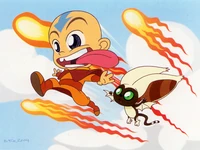
An early on example of the chibi-way artwork used in the Super Deformed Shorts.
The terminal affiliate features several additional pieces of artwork, such as promotional affiche drawings, the DVD and book covers. A birthday card, fatigued by DiMartino for a girl who "wanted [him] to brand Aang live", and several caricatures of other storyboard artists are also shown. It also explains how the beginning 'super deformed' (SD) version of the characters came to be and gives a detailed page of the unlike expressions used for the characters in the 3 shorts. In the second edition, a series of pages characteristic art drawn to enhance clemency funds during the COVID-19 pandemic. The finish of the chapter is a simple thank-you notation, acknowledging both their squad and the reader.
References
- ↑ i.0 1.1 Avatar: The Last Airbender—The Art of the Animated Series HC. Retrieved on July 25, 2020.
- ↑ two.0 2.ane 2.ii Comics Continuum: Dark Horse Comics for April. Retrieved on March 31, 2012.
- ↑ three.0 iii.1 Avatar: The Last Airbender—The Art of the Animated Series HC (Second Edition). Retrieved on July 25, 2020.
- ↑ rufftoon (May 19, 2010). It'south a practiced week for Avatar fans.. LiveJournal. Retrieved on July 25, 2020.
- ↑ Penguin Random House: Avatar: The Last Airbender—The Fine art of the Animated Serial (Second Edition). Retrieved on July 25, 2020.
See also
- List of Avatar books
- The Legend of Korra: Enhanced Experience
- The Fable of Korra—The Art of the Blithe Series, Book One: Air
- The Fable of Korra—The Art of the Animated Serial, Book Ii: Spirits
- The Legend of Korra—The Fine art of the Animated Series, Book 3: Alter
- The Legend of Korra—The Fine art of the Animated Series, Book Four: Residuum
Source: https://avatar.fandom.com/wiki/Avatar:_The_Last_Airbender%E2%80%94The_Art_of_the_Animated_Series
0 Response to "Avatar the Last Airbender the Art of the Animated Series"
Postar um comentário